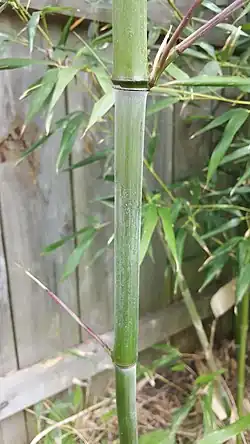Phyllostachys atrovaginata
| Phyllostachys atrovaginata | |
|---|---|

| |
| Scientific classification | |
| Kingdom: | Plantae |
| Clade: | Tracheophytes |
| Clade: | Angiosperms |
| Clade: | Monocots |
| Clade: | Commelinids |
| Order: | Poales |
| Family: | Poaceae |
| Genus: | Phyllostachys |
| Species: | P. atrovaginata
|
| Binomial name | |
| Phyllostachys atrovaginata C.S.Chao & H.Y.Chou
| |
| Phyllostachys atrovaginata | |||||||
|---|---|---|---|---|---|---|---|
| Traditional Chinese | 烏芽竹 | ||||||
| Simplified Chinese | 乌芽竹 | ||||||
| |||||||
Phyllostachys atrovaginata is a running bamboo with strongly tapered, stiff, upright culms. It may reveal a fragrant scent during warm weather or when vigorously rubbed. [1] The common name of "Incense bamboo" comes from the unique aroma. [2] Its culms grow large in diameter relative to height. [3] Maximum height can reach 10 m (33 ft) with a maximum culm diameter of 7.0 cm (2.7 in). [1] This bamboo grows in areas ranging from subtropical to temperate and tolerates winter temperatures down to -23 °C (-10 °F), [1] [2] being a more cold-hardy bamboo. [4] Like water bamboo, the rhizomes and roots of this species also have air canals as an adaptation for living in wet soil. [1][2] The specific epithet atrovaginata or "dark-sheathed" is inspired from the dark green and deep red wine colors of the culm sheaths. [1] P. atrovaginata has formerly been called Phyllostachys congesta. [1] [5]
Edible shoots can be harvested in spring from this cultivated species, while the culms can be used split or unsplit for weaving or crafting bamboo articles. [5] [6]
References
- ^ a b c d e f Daphne Lewis, Carol Miles. Farming Bamboo. Lulu.com. p. 128. ISBN 978-1-4357-0131-1.
- ^ a b c "Phyllostachys atrovaginata". Retrieved 2008-05-17.
- ^ "Phyllostachys atrovaginata". Archived from the original on 2008-04-20. Retrieved 2008-05-17.
- ^ "hardiness ratings". Archived from the original on 2012-06-19. Retrieved 2008-05-17.
- ^ a b "Phyllostachys atrovaginata Incense Bamboo". Retrieved 2008-05-17.
- ^ "Phyllostachys atrovaginata in Flora of China". Retrieved 2008-05-17.